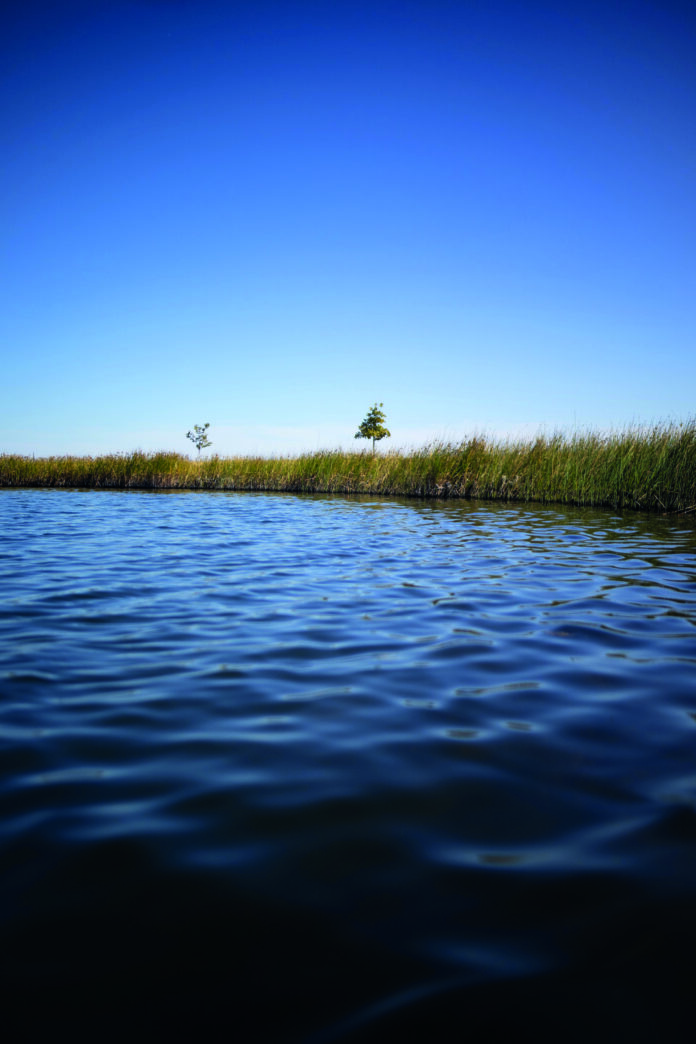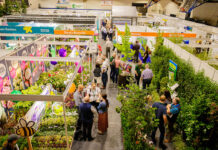If you are dipping your toe into pond design for the first time, then environmental consultant and writer Féidhlim Harty is at hand to offer his top tips on the design process, whether it’s for recreation, income or simply adding beauty to your environment
Farm ponds are enjoying a welcome resurgence within the Irish landscape. Their benefits are many and varied, ranging from water quality improvement to biodiversity enhancement area, to the beauty of still water reflecting a winter sky. Ponds also hold rainfall within the landscape, easing the impacts of both flooding and drought conditions; providing hydrological buffering for the wider catchment and a potential source of water for livestock.
On some farms, building a pond is as simple as digging a hole in a wet corner and allowing it to fill naturally with groundwater. In other areas, a synthetic liner may be needed to hold water. Water sources include groundwater, seasonal drains or springs and runoff from a shed roof or farm road. Silted runoff can be filtered through a wetland planted buffer zone to keep your pond water cleaner.
In-channel ponds within farm drains can in themselves act as filters and silt traps, holding winter runoff from fields or farm roads and allowing eroded soil and debris to settle. This keeps soil within the farm and protects downstream waterways from pollution. Even something as seemingly benign as soil and silt can be a challenge for aquatic wildlife, clogging spawning beds and reducing the biodiversity value of stony streams.
DESIGN CONSIDERATIONS
If you want to build a farm pond on your own land or for a client, there are a number of things to bear in mind during the process. Firstly, ask what you want the pond to achieve. Is it for wildlife, as a water source for livestock, for aquaculture to diversify farm income, for recreation or beauty? Each will lead down different boreens in the design process.
Step 1 in the design process is to select a suitable location. For wildlife, a secluded wet corner is ideal, where the minimum intervention is needed to achieve an area of open water. For irrigation, you’re best to keep the pond high in the landscape, allowing gravity to bring the water to where it’s needed. Where gravity falls are absent, a nose pump or solar pump help to keep cattle away from the pond edge during the establishment phase.
Next, assess your soil type and potential water sources. The less inputs you have, the better your pond seal will need to be. Thus if you have high groundwater, no liner will be needed, whereas if you have a pond that is rain-fed only, and your farm is mostly on free draining soil, then a synthetic liner will be required.
It can be helpful to draw a sketch of the proposed pond. This can help to clarify your ideas and communicate them to your digger driver and anybody else with an input into the process. For wildlife benefit, an undulating shape will help to maximise the edge length, and thus enhance this diversity-rich portion of your pond. A very shallow edge slope is useful for the same reason, as well as being safer. The topography of the field will also steer the design. A natural saucer of land lends itself to creating a pond far better than a raised mound, for example. Look closely at the land and endeavour to create the maximum area of standing water with the minimum of machine time. This focuses the mind on achieving a good landscape fit.
DIGGING IN
When digging, remember that you’ll create a mess that’s a lot larger than the final area of open water, so excavate an area that is a good bit bigger than your desired pond size. Start by scraping back the topsoil and spreading it somewhere useful such as over a field or as the base for a small orchard. Then dig out the subsoil. If you’re building your pond on a slope, then remove all the topsoil from beneath the retaining embankment as well as the pond area itself. That way when you go to build the banks you can place good clean clayey subsoil on top of clean clayey subsoil, avoiding a conduit for water through in situ grass and plant roots.
There’s no need to dig too deep. If you are creating a reservoir for irrigation then volume is going to be important, but for biodiversity ponds remember that most of the wildlife interest is in the shallowest few inches. You can combine the two design approaches if needed by keeping a shallow fringe on the outside of a deeper area.
High water table and heavy clay soils are the two most natural ways to achieve water retention in your pond. However, if your soil needs a liner, then be sure to prepare the ground well so that there are no sharp objects or undue undulations that could damage the plastic. Avoid stretching the liner when laying, or it may lead to tears or punctures. Cover with 6” or more of clean subsoil for protection, and also ensure that livestock can’t enter and walk on the finished pond edge and the vulnerable liner beneath.
There are many plastic liner types that can be used, including heavy duty polyethylene (HDPE or LDPE, 0.5-1mm thick), synthetic butyl (EPDM, 1mm), or even several layers of silage pit cover plastic. This last option is a very light liner that punctures easily but can be effective on soils that are already high in clay and where some leakage can be tolerated. Polytunnel plastic provides a middle ground between the high and low-cost options, and can be further protected by geotextile membrane top and bottom. As a general rule, I avoid PVC liners due to the inherent toxicity in manufacture, recycling and disposal. Clay, bentonite and geosynthetic clay liners are more natural liner types than the plastic options listed here, but my experience with these is limited so I won’t comment further on their use.
Overflow detail is important, particularly if your pond is part of a farm drain. The last thing you want is to have your retaining embankment washed away in the first downpour. Erosion can be minimised or prevented by placing a pipe through the new bank, spilling onto a stone splash desk to dissipate flow velocities. Compact well around the pipe with your heel to achieve a solid clay seal. An elbow on the upper side of the pipe can allow for adjustment of pond depth if needed. Select a pipe diameter appropriate to the throughput volumes, such that all or most of the heavier rainfall events can flow through unhindered. A wide grassed spillway can channel extreme events. On the law of averages, your embankment will have had time to consolidate and green over before this occurs, and the duration should be brief at any rate. This allows for bypass of water in the event of a pipe blockage or flood event, keeping water within the main farm drain rather than spilling out and causing flooding elsewhere.
SOME DON’TS
There are a few important boxes to tick in the “things to avoid” category. Don’t flood your neighbours: where falls are modest on farm drains, any dams have the potential to back up water into neighbouring land. Take care to properly assess the levels beforehand so that you keep your neighbours happy. Likewise, don’t hold water in the landscape if a dam-break will cause damage to people or property downhill.
Don’t create a safety hazard: avoid digging too deep or with steep edge-slopes that can become covered with a dangerous coat of green pondweeds. Don’t step outside the law by working in a stream channel without permission from Inland Fisheries Ireland or changing ground levels by more than one metre without planning permission; easier to stick to shallower digs and seasonal farm drains or a stand-alone pond in a wet field.
Don’t place excavated soil uphill of your pond or you will divert potential inputs of water that would otherwise replenish your pond. Don’t be too neat in your edge finish: undulations and variations provide extra habitat potential for wildlife. At the same time, don’t leave the perimeter so rough that you create a trip hazard for people walking around the pond. Don’t drive on your pond if you’ve got a liner in there: it’s remarkably easy to puncture a liner with heavy machinery. Don’t rush to plant the pond edge: more on that later. Don’t overthink it all:it’s much better to make a few mistakes in draft one and then build another each time you bring a digger onto the farm than to leave it as just a sketch forever.
PLANTS AND PLANTING
I’ve been planting reed beds and constructed wetland systems since the early 1990s, so it’s the most natural thing for me to list all the species that can provide filtration, wildlife benefit and beauty around a pond edge. However, the more I look into building ponds for wildlife, the more value I see in steering away from planting and simply letting nature take its course. Bare soil edges provide a valuable habitat in their own right; one that will green up quite quickly by natural colonisation anyway. If you adopt an attitude of curiosity you can watch as plants from the locality migrate into your pond and bring in local flavour and colour. If you want to ignore this advice and have edge plants sooner than natural colonisation will provide, then I urge you to source your plants from a local ditch, pond or stream rather than buying in non-native species or Trojan invasives along with the bought plants.
LONG-TERM MANAGEMENT
So, your pond is in and the rain or drains have filled it to the overflow point and you can hear the trickle of water flowing out into the wider catchment. You’re watching for birds and insects that arrive. The odd wetland plant seedling has sprouted from wind-blown seed. What’s next in terms of management and care? If animals have access to the pond field, then be sure to fence them out so that they don’t damage dams, overflow pipes or liners. Some trampling is part of a natural water’s edge ecological dynamic, but it’s best not to muck up the edges and water too much by letting cattle free roam into the pond.
Another management consideration is to watch for invasive species. Non-native invasives can cover your pond surface rapidly if they take hold. If you see signs of non-native invasive species in the early stage of establishment, remove them as they appear and dispose of them with care to avoid spreading them further.
Note that native species such as bulrush (Typha sp.) and common reed (Phragmites australis) are also very vigorous plants that can cover pond edges and encroach into water more than a metre deep. If you want to preserve your open water pond for longer you may wish to hand weed these species as they appear. Less vigorous species such as yellow flags (Iris pseudacorus), water mint (Mentha aquatica) and others will allow a greater diversity of species to co-exist into the longer term.
Over time you may find your pond begins to silt up, particularly if built into an existing farm drain. When cleaning out silt and debris from your pond, only dredge up to one-third of the total pond area in any given year. This will allow time and space for insects and plants to survive and thrive between maintenance intervals. Similarly, in farm drains up-gradient of your pond, take care to only clean drains in short bursts of 10-20m leaving a 10-20m buffer stretch of planted drain behind to continue acting as a filter. Otherwise, your pond will become silted all the more quickly as soil moves unhindered from field to drain to pond. Likewise, if you can leave a 5-10m buffer of permanent pasture, ungrazed verge or wooded edge between sloping fields and your new pond, this will help to trap silt and nutrients; lengthening the life and strengthening the vitality of your pond.
ENJOY WATCHING THE PROCESS
As your pond matures and evolves, take the time to enjoy watching the wildlife that visits. Enjoy the sound of the water flowing after heavy rain, the wind in the reeds, the chatter of swallows, the hum of bees. We live in a country that has a rich abundance of wetland habitats, from estuaries to rivers to lakes. Your pond will provide a stepping stone between watery habitats in the wider landscape as well as a habitat in its own right. The wild life in the countryside has been under too much pressure for too long. Enjoy watching as the tides change, the richness remerges and our farms flourish with a renewed abundance of nature alongside the crops we nurture and grow. ✽










